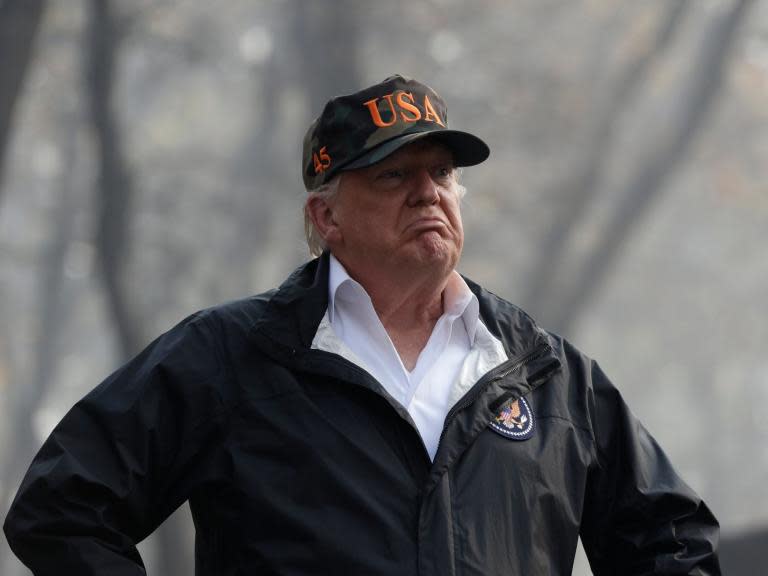No Donald Trump, we aren't going to have 'great climate', and poor forest management only plays minor role in wildfires
In scenes mirrored in Greece in July and Portugal last year, California has become the latest to grapple with the aftermath of devastating wildfires. With homes burning down, cars incinerated, tragic deaths, exhausted firefighters tackling the flames, and residents wearing looks of disbelief on their faces, saying, “this can’t be happening, this can’t be happening to us”, it’s hard not to question what went wrong.
And it’s here where, unusually, Donald Trump has a point – at least in part.
We know what you’re thinking: “What’s this? Scientists agreeing with Trump?” But hold on, don’t give up on us yet. Let us explain which part we agree with.
Days after the blaze tore through the region, Trump tweeted: “There is no reason for these massive, deadly and costly forest fires in California except that forest management is so poor. Billions of dollars are given each year, with so many lives lost, all because of gross mismanagement of the forests. Remedy now, or no more Fed payments!”
He has the “gross mismanagement of the forests” part right, although it is dangerously wrong to assume this is the main reason for the fires and can readily be fixed. When asked whether his visit to the scenes of devastation had changed his view on climate change this weekend, Trump added: “I want a great climate and we’re going to have that and we’re going to have forests that are very safe”.
The Californian fires, “massive, costly and deadly” as the US president accurately described them, are the result of different factors combined.
To start with, it is crystal clear that climate change is a contributing factor (which, unfortunately, will not result in the “great climate” Trump predicts). California is no stranger to prolonged hot and dry weather that dries out vegetation as well as strong winds that hurtle fires across its landscapes.
However, it is now well established that climate change has led to longer fire seasons. Furthermore, temperatures do not fall as much at night as a decade ago, which means that fires now burn more ferociously and travel further overnight.
It is also true that “billions of dollars are given every year” in aid of wildfires, and indeed they are not used in the best possible way to fix the “wildfire problem”. In fact, the way funding is spent sometimes only worsens it in the longer term.
Most of the money spent around wildfires is assigned to suppression costs, meaning, fighting fires. But (and this is a big but) keeping fire out of landscapes where wildfire is a natural part of the ecology means allowing life and dead vegetation to accumulate, making the next fire even more extreme.
Obviously, once a fire is going, efforts need to focus on reducing impacts on people. That can be both very costly and dangerous but, for sure, needs to be the top priority for fires that threaten human lives.
But (another big one here), as the forest services, fire managers and academics have been crying out loud for years, the money could be spent much more effectively in fire preparedness and mitigation (ie learning to co-exist as safely as possible with fire).
“Remedy now”, sure, but how? Complex problems need complex solutions, and, just as importantly, joint solutions.
If the forest service could use more resources on risk mitigation, this would be a start. Prescribed burns and thinning of vegetation, for example, help reduce the risk of extreme fires occurring, but that is only one side of the story.
Many fires start outside of forest service land and, also, many times, there is little firefighters can do under extreme fire weather, as was the case in Paradise with their mix of highly flammable vegetation and buildings.
In fire-prone landscapes, be it in California, Greece or Portugal, wildfire is everyone’s problem. And to be able to effectively tackle it we need to understand this. All of us.
This includes the politicians who distribute funds and pass laws; the land managers who decide on strategies to reduce risk from fire; the residents who live in fire-prone landscapes and can minimise risk by limiting flammable material in and around their properties.
It even includes the many of us who live in areas far away from wildfires and, shocked by the scenes on television screens, are made to believe that such disasters can be prevented by better forest management alone.
We all need to understand that we live on a planet where wildfires, just like earthquakes, volcanic eruptions or hurricanes, do happen. Fire has been here for much longer than us and it will, for sure, stay longer. And in our warming climate, it will continue to get more extreme in many regions. We cannot completely control it, we can’t completely stop it, but we can surely do a lot more to keep out of its way.
Wildfire is not going away. This is the plain but uncomfortable truth. Ignoring reality only fuels the flames of a culture of blame and unrealistic expectations. Using the recent words by wildfire expert at Arizona State University, Stephen Pyne, we need to learn how to speak a language that fire understands because, in truth, it really doesn’t care about our pain.

 Yahoo News
Yahoo News 

